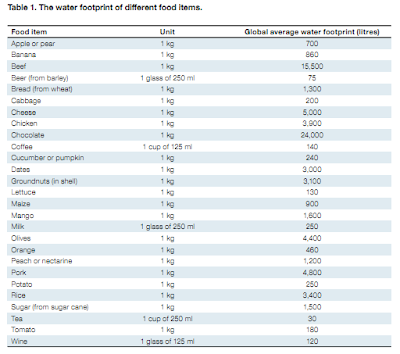Water, Water, Everywhere
Nor any drop to drink...
On Tuesday 7 June WaterAid will be hosting a non-stop tweetathon – hashtagged #WaterAid24 - to show supporters exactly what an international charity does over a 24-hour period.
The important issue of water use, conservation and availability is often overshadowed by the battle to cut carbon emissions. To highlight the issues, here are a selection of statistics from WaterAid's website:
On Tuesday 7 June WaterAid will be hosting a non-stop tweetathon – hashtagged #WaterAid24 - to show supporters exactly what an international charity does over a 24-hour period.
The important issue of water use, conservation and availability is often overshadowed by the battle to cut carbon emissions. To highlight the issues, here are a selection of statistics from WaterAid's website:
- 884 million people in the world do not have access to safe water. This is roughly one in eight of the world's population. (WHO/UNICEF)
- 2.6 billion people in the world do not have access to adequate sanitation, this is almost two fifths of the world's population. (WHO/UNICEF)
- 1.4 million children die every year from diarrhoea caused by unclean water and poor sanitation - 4,000 child deaths a day or one child every 20 seconds. This equates to 160 infant school classrooms lost every single day to an entirely preventable public health crisis. Diarrhoea kills more children every year than AIDS, malaria and measles combined. (WHO/WaterAid)
- At any given time, close to half the people in the developing world are suffering from one or more of the main diseases associated with dirty water and inadequate sanitation such as diarrhoea, guinea worm, trachoma and schistosomiasis. (UNDP Human Development Report 2006)
- Half the hospital beds in developing countries are filled with people suffering from diseases associated with poor water, sanitation and hygiene. (UNDP Human Development Report 2006)
- The weight of water that women in Africa and Asia carry on their heads is commonly 20kg the same as the average UK airport luggage allowance. (HDR)
- The average person in the developing world uses 10 litres of water every day for their drinking, washing and cooking. (WSSCC)
- The average European uses 200 litres of water every day for their drinking, washing and cooking. North Americans use 400 litres. (HDR)
- On current trends over the next 20 years humans will use 40% more water than they do now. (UNEP)
- Over the past 10 years, aid to health and HIV/AIDS in Sub-Saharan Africa has increased by nearly 500%, while aid to water and sanitation has increased by only 79%. (OECD)
Source: http://www.waterfootprint.org/Reports/Hoekstra-2008-WaterfootprintFood.pdf; WaterStat, Water Footprint Network, Enschede, the Netherlands
Around two thirds of the water footprint of the UK is actually sourced from abroad as the figure below nicely shows. The numbers show that significant quantity of this water footprint comes from areas with low rainfall and high water stress including India, Pakistan, South Africa and Egypt. The availability of water in a region is measured using the Water Stress index which evaluates the ratio of total water use (sum of domestic, industrial and agricultural demand) to renewable water supply, which is the available local run off (precipitation less evaporation) as delivered through streams, rivers and shallow groundwater. The areas with the highest water stress are in the Middle East and North Africa and some nations from this region are using their oil wealth to buy up land in wetter areas to grow food for export back home - putting greater pressure on water resources for the local populace.
As with all our environmental problems, things are only going to get worse and there are no easy solutions, but the work of organisations such as WaterAid does help alleviate the daily difficulties which communities face in getting enough safe drinking water and sanitation. And when you sit down to your well deserved cup of tea, ponder on the 30 litres of water that went in to making it!
Source: Chapagain, A. K. and S. Orr (2008) UK Water Footprint: The impact of the UK's food and fibre consumption on global water resources, Volume 1, WWF-UK, Godalming, UK.Downloadable from www.waterfootprint.org or MyDocs


Comments
Post a Comment